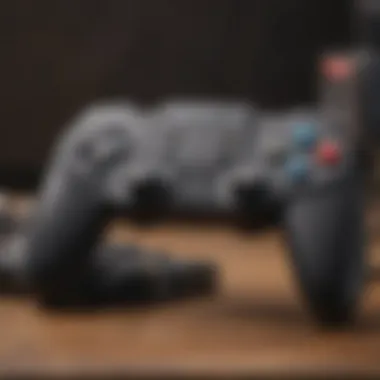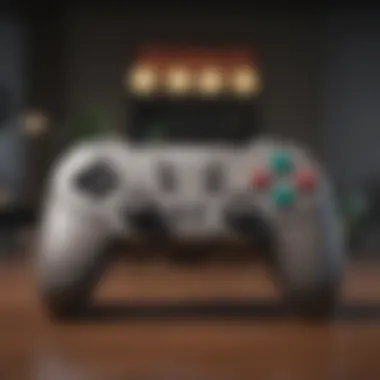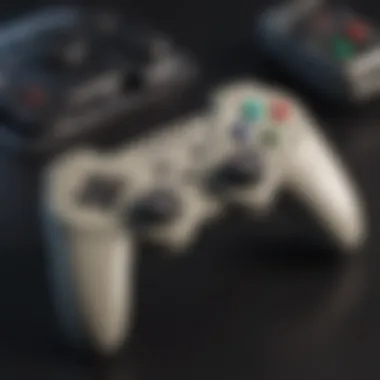The Evolution of Wireless N64 Controllers


Intro
As gaming technology continues to evolve at breakneck speed, it becomes vital to look back and appreciate milestones that shaped our gaming experiences, especially in the realm of peripherals. Among these pivotal moments is the transformation of the Nintendo 64 controller. Initially tethered to the console by a cord, the N64 controller was iconic, yet the advent of wireless technology changed the game—literally and figuratively.
Wireless controllers have changed how games are played, introducing a freedom of movement that fundamentally alters user engagement. This narrative weaves together historical context, technical specs, and the various user experiences associated with wireless adaptations of the N64 controller. Digging deeper into this topic reveals a fusion of nostalgia and innovation, demonstrating how past designs can influence modern gaming technologies.
The aim here is to forge a comprehensive understanding of the wireless innovation surrounding the N64 controller, exploring its roots, its path of development into the wireless realm, and how it fits into the broader landscape of gaming today.
Preamble to N64 Controllers
The Nintendo 64 controller represents a turning point in gaming history, more so as it shifts into a wireless realm. This introduction serves not just as a preamble but as a key to understanding how early designs laid the groundwork for today’s gaming interfaces. Recognizing its historical importance is essential, as it informs the innovations we’ve seen in contemporary controllers. Classic features like the three-pronged design and the distinctive analog stick set it apart, offering unique advantages at the time of its launch.
Historically, the N64 controller came into play during a time when gaming was growing in complexity. Its introduction in 1996 coincided with the rise of 3D gaming, bringing forth a need for specialized controls. This meant greater engagement and immersive experiences for players. The move toward wireless technology is now reshaping these controllers into modern, clean designs while retaining the spirit of what made the original memorable.
Besides the look, the feel of the controller itself carried weight. Gamers resonated with its robust structure and the tactile feedback it provided. As we now journey into wireless adaptations, it’s clear that the N64 controller's historical significance prepares us for a deeper dive into how these adaptations affect both gameplay and user experience.
Historical Significance
The N64 controller, emblematic of its era, made waves not just for its design but also its function. It was the first to incorporate an analog stick, creating a more fluid gameplay experience, especially in 3D environments. This was a significant evolution from the traditional D-pad that dominated previous consoles.
Through its design choices, Nintendo also catered to various gaming styles with its hybrid layout: the three-prong grip allowed for versatility in control. Games like "Super Mario 64" and "The Legend of Zelda: Ocarina of Time" utilized these features effectively, earning the controller a place in gaming history. Its historical significance is best captured by how it influenced other consoles, spawning advancements that would’t have been possible without it.
Iconic Design Elements
Digging deeper into the design, the N64 controller boasts several iconic elements worth noting. First off, its three-pronged design was a departure from norms. The unique layout not only felt distinct but also encouraged different grip styles suitable for various game genres. The primary analog stick is often regarded as a flagship feature; it offered a degree of precision that changed how players interacted with games.
Its color range also became a talking point among fans, from the original grey to vibrant hues that reflected personality and preference. This personable approach didn’t just cater to gameplay; it created a community around collecting. Every detail was intentional, ensuring gamers felt connected not just to their console but also to the wider gaming culture.
"The Nintendo 64 controller wasn't just a tool; it became an extension of the gamer, blending function with the individual’s expression."
In branching into wireless territories, these design elements can still be seen, albeit improved. Comfort and ergonomics are prioritized even more, ensuring the nostalgic essence of the original N64 controller remains intact while the technology itself races forward.
The Advent of Wireless Controllers
The advent of wireless controllers marks a pivotal transition in gaming history. This shift has not only changed how gamers interact with their consoles but has also shaped the entire experience of playing video games. By delving into this topic, we can uncover the nuances and implications of this technological leap, especially as it relates to the iconic N64 controllers.
A Shift in Gaming Technology
The move to wireless controllers began in earnest with the growing demand for freedom of movement and convenience in gaming. Early controllers tethered players to their consoles, which greatly limited their range and introduced an element of frustration. As gaming evolved in the late 1990s and early 2000s, companies recognized the need to break these chains. The Nintendo 64, despite being a product of its time, was pioneering in many ways, and the prospect of wireless controllers showcased the desire for innovation.
This shift can be notably traced to technological advancements in radio frequency communication. Early wireless systems were often plagued by issues, such as interference and limited connectivity range. Yet, as battery technology improved and encoding technology became more sophisticated, these obstacles were systematically addressed. Thus began a new era where gamers could finally sit back, relax on their couches, and immerse themselves in their favorite titles without the hindrance of clunky wires.
More than just a trending excited buzz, this change fundamentally altered the dynamics of multiplayer experiences too. With wireless controllers, multiplayer sessions became more social, allowing players to move around freely, collaborate, or compete with fewer restraints. The tactile joy of gaming was no longer confined to the sofa; it transformed into a shared experience that echoed camaraderie.
Benefits of Going Wireless


The benefits of going wireless extend way beyond just freeing up space. The transition to wireless technology in controllers has provided a range of advantages:
- Enhanced Freedom of Movement: Players can move freely without the risk of tripping over cords, which is especially valuable in multiplayer sessions.
- Increased Convenience: No more fussing with tangled wires. Wireless controllers allow for easy storage and setup.
- A Cleaner Setup: The gaming area can look less cluttered, making it more visually appealing and organized.
The ability to customize your gaming space is another crucial advantage of wireless controllers. Picture playing Mario Kart with friends, all while seated comfortably across the room instead of huddled around a console. This kind of flexibility enhances the whole experience.
Moreover, the technology provides an opportunity for future improvements. From haptic feedback to motion controls, wireless technology can support innovations that wired controllers simply cannot accommodate. This opens doors to more engaging, immersive, and versatile gaming experiences.
"The evolution of gaming peripherals is like an open highway—one that leads directly to future innovations and more player-friendly experiences."
Wireless N64 Controller Technologies
The landscape of gaming has seen immense changes over the years, with the introduction of wireless technologies being one of the most substantial advancements. This section dives into the intricacies of wireless N64 controller technologies, focusing primarily on the communication standards that facilitate connectivity and the critical aspects of battery management. Understanding these elements is essential for any gamer looking to enhance their experience while embracing the advancements made in controller design.
Wireless Communication Standards
Wireless communication standards form the backbone of how data is transmitted between the controller and the console. Various technologies have been adopted over time, each with its own set of advantages and challenges. The most notable wireless standards that have influenced the development of N64 controllers include Bluetooth and proprietary RF (Radio Frequency) solutions.
- Bluetooth: This technology is widely recognized for allowing seamless connections between multiple devices without much hassle. Known for its stability and decent range, Bluetooth has become a staple in the realm of wireless controllers. However, it isn't without its drawbacks - latency can still be an issue in high-paced gaming scenarios where every millisecond counts.
- Proprietary RF Solutions: Many N64 wireless adaptations leaned towards proprietary RF technologies, designed specifically for controllers. These systems typically offer a lower latency compared to Bluetooth, which can be crucial for fast-paced games like Mario Kart 64. However, they may be limited in range and require specific dongles or adapters that might not be universally compatible with all devices.
These communication standards not only influence gameplay but also shape the controller market itself. Options that draw on these technologies cater to varying user preferences, from those seeking low-latency experiences to those who prioritize ease of accessibility.
"The essence of gaming grows as we embrace the tech behind it, where controllers are no longer just wires binding us to our screens."
Battery Life and Management
Battery life and management are critical factors in the usability and enjoyment of wireless N64 controllers. As gamers would attest, a dead battery can interrupt the flow of gameplay at the worst possible moment. Thus, manufacturers have gone to great lengths to enhance battery performance while ensuring that users won’t be frequently faffing around with replacing or recharging their batteries.
Several features and technologies have come into play:
- Rechargeable Batteries: Many modern wireless controllers now come equipped with rechargeable battery packs. This eliminates the hassle of changing AA batteries frequently, allowing for longer, uninterrupted gaming sessions. Rechargeable options also benefit the environment by reducing waste.
- Energy-Efficient Designs: With advances in technology, controller designs are increasingly becoming energy-efficient. Sensors that detect inactivity allow the controller to enter low-power mode, preserving battery life when not in use.
- Battery Indicator Features: Smart controllers often include battery level indicators, giving users a heads-up on when to charge. This way, gamers can plan their sessions and avoid those unfortunate surprises that come with unexpected battery failures.
Key Features of Wireless N64 Controllers
The evolution of the N64 controller into the wireless realm isn't just about removing cords; it's a rethinking of comfort, flexibility, and personalization. These innovations have made an impact on how gamers interact with their classic favorites and modern titles alike. In this section, we’ll dig into the key features that have emerged in wireless N64 controllers, emphasizing ergonomic design and customization capabilities—both vital for enhancing the user experience.
Ergonomics and Comfort
Ergonomics in gaming controllers is crucial, particularly when you're pouring hours into nostalgic title like Super Mario 64 or Zelda: Ocarina of Time. The N64 design originally aimed for a unique grip, but wireless versions have taken this to another level.
Wireless N64 controllers tend to be more contoured than their wired predecessors. This means that with a thoughtful design, they can fit comfortably in the hand, providing natural support whether you’re playing a lengthy session or just killing time in Mario Kart. A significant improvement in wireless models is the weight distribution. Many gamers have expressed how models like the RetroBit Wireless Controller dodge the heavy, awkward feel that can arise from certain gaming sessions.
Not only have these controllers grown less cumbersome, they’ve also adopted materials that enhance grip. Rubberized surfaces, for example, allow players to maintain control even during those intense moments.
"Comfort isn’t just a luxury; it’s a necessity. When every second counts, a comfortable grip makes all the difference."


Customizable Button Layouts
Another standout characteristic of modern wireless N64 controllers is their customizable button layouts. This aspect really resonates with the competitive gaming community. Individual gamers have different needs, whether it’s adjusting for accessibility or optimizing performance.
Options may include remapping buttons to better suit one's play style or preferred grip. Imagine playing GoldenEye 007 where you can set the fire button on your thumb, making rapid shots a breeze instead of an awkward reach. Beyond simple remapping, some controllers allow players to create profiles tailored for different games. A single click switches the layout for Zelda from the action setup of Doom 64.
The possibility for personalization not only enriches gameplay but empowers players. It’s almost like a badge of honor when you find the perfect configuration for your style. Customizability in button layouts isn’t just a gimmick; it enhances overall performance and enjoyment.
These features set the stage for a more immersive gaming experience, positioning the wireless N64 controller not merely as a replacement but an upgrade. The intersection of privacy, comfort, and adaptability trends collectively transforms the attachment players have to the N64, marrying nostalgia with modern innovations.
As we continue exploring this growth, it becomes clear how craftsmanship and user input shapes the future of wireless controllers.
User Experience with Wireless N64 Controllers
As the gaming landscape evolved, so did the user experience with controllers, particularly with the transition from wired to wireless models. The N64 controllers have a storied legacy, and their wireless counterparts bring both nostalgia and modernity to players’ hands. In a world where flexibility and ease of use reign supreme, it is crucial to understand how these innovations shape the overall gaming experience.
Comparing Wired and Wireless Usability
When comparing wired and wireless usability, one might think it’s all about connectivity. However, there are layers to this discussion worth peeling back. With wired controllers, there's a sense of stability—no lag, no interference, just a direct line from your hands to the screen. But, let's face it, the cumbersome cords can feel like a straightjacket, binding players to a specific spot on the couch.
In contrast, wireless N64 controllers usher in a new level of freedom. Players can move around, adjust their seating, or even stand up and dance a bit during epic battles. This flexibility enhances immersion in gameplay. For example, in a multiplayer setting, one does not have to worry about stepping over cables or being anchored to a seat.
Moreover, the usability of wireless devices has improved immensely with recent technology. Most gamers prefer the seamless experience wireless technology offers, highlighted by the absence of lag or latency due to the rapid advancements in signal processing. For many players, this shift feels like taking a weight off their shoulders, allowing for a more relaxed and enjoyable game session.
Feedback from Gamers
Feedback from gamers about wireless N64 controllers can be a treasure trove of insights. Players often report a mix of nostalgia tied with excitement at these systems' advancements. Many say that the very thought of picking up a wireless N64 controller rekindles memories of childhood gaming sessions while allowing them to enjoy modern conveniences.
A common theme running through gamer reviews is the joy of reclaiming space. "I can move around without the fear of tripping over cords, which is fantastic," one gamer expressed on a forum. Others mention their preference for the sleek designs of wireless models, many of which boast ergonomic adjustments to better fit in the hands compared to their wired predecessors.
Yet, not all feedback is overwhelmingly positive. Some players have raised concerns about battery life, leading to moments of frustration during intense gameplay sessions. For instance, "It always seems to die during a boss fight," lamented one gamer on Reddit—a sentiment echoed by many.
Despite such hiccups, the consensus is clear: the freedom and flexibility of wireless technology significantly enhance the gaming experience. As developers continue to evolve these devices, taking player feedback seriously will be essential in shaping the next wave of gaming controllers.
"Wireless controllers free us from the constraints of technology. It’s not just about playing; it’s about enjoying the game without limitations."
—Anonymous Gamer
Challenges in Development
As the gaming industry continues to evolve, the development of wireless controllers, especially for a beloved console like the Nintendo 64, presents unique challenges. These hurdles play a crucial role in shaping the user experience and ultimately determine how gamers perceive the quality and functionality of their devices. In this section, we’ll delve into some of the most prominent issues developers face, focusing particularly on latency and compatibility.
Latency Issues
Latency is one of the most pressing concerns in the development of wireless controllers. In the world of gaming, even a slight delay can significantly impact gameplay, especially in fast-paced titles such as GoldenEye 007 or Super Smash Bros.. Gamers expect instant feedback for their actions, an expectation that wired controllers largely fulfill due to their direct connection.
Wireless controllers, on the other hand, have to contend with the complexities of transmitting signals through the air. This can introduce a noticeable delay, commonly referred to as input lag. A lag of just a few milliseconds may not sound like much, but in competitions where split-second decisions can make or break a match, this can be a deal-breaker.


Developers are constantly working to minimize latency through various strategies. Some employ advanced algorithms that prioritize signal transmission efficiency, while others have turned to high-speed wireless standards to ensure swift communication. Ultimately, the goal is to make the wireless experience as seamless as possible, matching or even exceeding the performance of their wired counterparts.
"Reducing latency is not just a technical challenge; it's a matter of perception for gamers who crave responsiveness and precision."
Compatibility with Games
Another significant challenge in the development of wireless N64 controllers is ensuring compatibility with the vast library of games available for the Nintendo 64. Each game may have its own unique control mechanics, and a controller’s ability to adapt to these differences is paramount.
When transitioning to wireless technology, developers often face obstacles in how well the new controllers can replicate the functionalities of the original wired ones. Key elements such as button mapping, feedback mechanisms, and even the tactile feel of the buttons must remain true to the original design. If a player must struggle to relearn a control scheme or experiences a lack of responsiveness, the essence of what made the N64 controller beloved could be lost.
To tackle these issues, developers might consider integrating customizable features that allow users to adjust settings according to their preferences. For instance, implementing adaptive profiles for different games can offer a tailored experience, helping to bridge the gap between nostalgia and modern innovation. However, this also adds another layer of complexity in development, as extensive testing across a range of titles becomes necessary.
The Future of Wireless N64 Controllers
Future considerations for wireless N64 controllers are not only fascinating; they also pave new pathways for gaming technology as a whole. As the market marches towards increased mobility and streamlined experiences, the evolution of these controllers holds a mirror to broader trends within the segment of gaming peripherals. Shifting consumer expectations, combined with advancements in technology, signal meaningful transformations ahead. Factors such as ease of integration, latency management, and enhanced user interaction are at the forefront of these changes.
Innovations on the Horizon
Innovation is a buzzword that tends to circulate constantly around any discussion of gaming technology. When it comes to wireless N64 controllers, several trends seem poised to emerge. Among them are the possibilities of advanced haptics and adaptive triggers that respond differently based on the games being played. Imagine a controller that doesn’t just vibrate but varies its feedback based on in-game scenarios, enhancing immersion.
Another key element includes incorporating AI-driven customization, allowing the controller to adapt its layout based on the player's preferences or gameplay styles. This could lead to layouts that feel tailor-made for each individual rather than a one-size-fits-all approach. Furthermore, improvements in wireless technology could significantly enhance the range and reliability of these controllers, making lag and disconnection issues a thing of the paast.
Moreover, as battery technology strides forward, longer-lasting batteries that charge while being used could also hit the market. Self-recharging systems, like kinetic energy harnessing, are also becoming feasible. This would mark a significant leap forward, permitting uninterrupted gaming sessions—an irresistible prospect for die-hard Nintendo fans.
Potential Collaborations
As the saying goes, "Two heads are better than one," and the future of wireless N64 controllers could very well look like a coalescence of creativity from various tech domains. Collaboration between hardware designers and game developers might yield specialized controllers that are optimized for specific games or genres. Consider the potential for controllers designed specifically for racing games or RPGs that might come with dedicated functionalities tailored to enhance those experiences.
Additionally, partnerships with tech giants, like companies that specialize in wireless communication or battery technology, could foster innovations previously deemed out of reach. Imagine a wireless N64 controller that uses 5G technology to offer near-zero latency. That would truly redefine how players interact with their games.
Furthermore, there might be a rise in community-driven development, where fans design and modify their controllers. Platforms like Reddit and forums could become hubs for sharing these custom designs.
"The marriage of innovation and collaboration is where the magic will happen for wireless N64 technology."
This landscape brims with possibilities, indicating that the future is not just about novelty, but about elevating what it means to game as a community and experience as individuals. As the industry continues to adopt these changes, the wireless N64 controllers may very well become a benchmark for the next generation of gaming experiences.
Closure
In the vast expanse of gaming history, the evolution of the Nintendo 64 controller stands as a testament to how technology reshapes our interaction with virtual worlds. The transition from wired to wireless functionality has significantly impacted how players engage with games, marking a pivotal shift in the user experience.
Reflections on Gaming Evolution
As we glance back at the timeline of gaming, it becomes crystal clear that controllers are not merely tools; they serve as a gateway into immersive experiences. The N64 controller, with its distinctive design, once epitomized the intricate connection between player and game. However, with the advent of wireless technology, players can now revel in unshackled freedom. This shift away from tangled cords heralds not just convenience, but also a broader accessibility. Players can move freely, no longer limited by the confines of their gaming setup. The ease of use, combined with the ever-growing game catalog, accentuates the enjoyment factor that game enthusiasts crave.
The Enduring Legacy of the N64 Controller
Despite the rapid advancement of gaming technologies, the N64 controller's design and concept continue to echo through time. Many new controllers owe their features to this groundbreaking device. Its legacy lives on, influencing everything from handheld devices to advanced wireless controllers that dominate the market today. The nostalgia attached to the N64 experience often rekindles a sense of community among gamers, as shared memories of gameplay foster connection. This enduring presence ensures that both old and new players recognize the impact the original N64 controller had on shaping the future of gaming peripherals.
"The controller is more than just a piece of hardware; it embodies the shared moments and adventures we had playing games with friends and family."
As we embrace innovations on the horizon, it’s essential to acknowledge how rooted the N64 controller’s principles remain in modern designs. Its legacy, intertwined with the evolution of wireless technology, continues to resonate, reminding us that while gaming may evolve, the core essence of play remains timeless.



